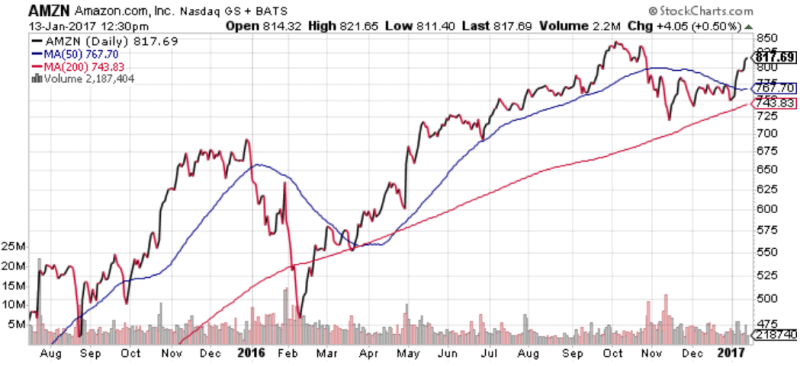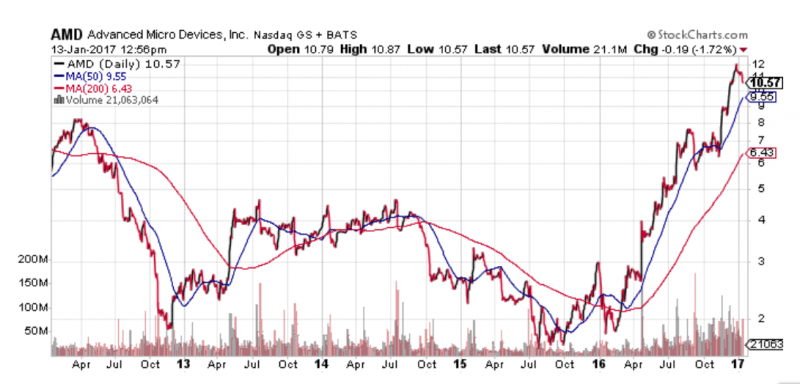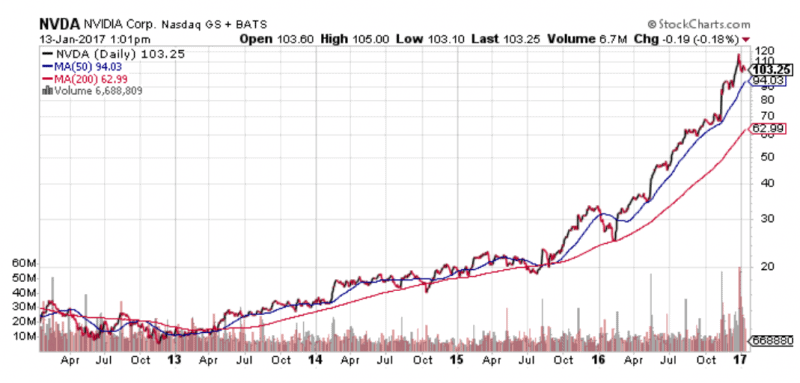Cloud computing and AI are becoming staples of everyday life – even if you don’t know it. The cloud is ubiquitous (by design and by adoption), and artificial intelligence, a completely different area in tech, is reaching into our lives in ways previously unimaginable. The stocks operating in these sectors are in favour for financial investors currently even though their valuations based on price/earnings and price/earnings/growth ratio may be a bit high. NVIDIA and AMD generated more than 3x return just in the last year, and these are not penny stocks; they are worth billions of Dollars.
Even at our FinTech start-up CityFALCON, we are looking to leverage the Cloud and AI to provide a better user experience and of course solve one of the biggest problems today – remove the noise including spam and identifying relevant and personalised stories for your watch list or portfolio.
In this article we will look at the companies behind these services (often the same companies participate in both), and how the societal shift from personal computing to cloud computing, plus artificial intelligence, will impact their stocks.
What is cloud computing?
“The Cloud”, as it has been nicknamed, is the networking of computers for specialized services. The most common implementation of The Cloud, so far, has been for storage: huge data centers hundreds or thousands of miles away store your data. This started off as a backup for your files, in case your drive became corrupted or your physical machine was otherwise destroyed. It was also implemented in a way with Facebook and similar social media platforms, because you could store your pictures and thoughts far away. Today many people simply store all their files on the cloud and forget the local hardware. In a way, this is great for retention. The companies that offer cloud storage (Amazon, Google, among others) are major tech companies, and they often have multiple backups of their data, so even if their drives in one place fail, they still have copies somewhere else. You pay a small fee for this (or, in some cases, like Google Drive, it is free to a point), but you don’t have to buy your own servers, hard drives, and multiple physical locations.
The other components of cloud computing are less common but even more powerful; as technology progresses and the Cloud becomes more culturally acceptable, the more these other aspects will become commonplace. These include Infrastructure as a Service (Iaas), Platform as a Service (PaaS), and Software as a Service (SaaS). These are the cloud-based operating systems (what you get in a Chromebook), the cloud-based software suites (Office 365), and the remote monitoring of operations (such as Amazon Web service). Moreover, there is the component that is data-crunching on the Cloud. A good example of this component is SETI (Search for Extraterrestrial Intelligence), where individuals can participate in the search by donating processing time on their own machines. It now goes the other way, too, where companies can send data to tech firms like Amazon, and the calculation-heavy processing can be done on machines and setups far more powerful than many small- and medium-sized companies are willing to purchase.
With the move toward the Cloud for such essential services, Internet access will become as important as electricity. While this is indeed philosophically interesting, it also means the industry will become indispensable.
Weak AI has been around for a while (at least in tech terms). Siri was one of the first widespread, commercially available forms of weak AI. It is very good at doing one job, which namely is assisting you. Much further back, there was AI capable of beating humans in checkers, then chess, and now Go. The Furby doll craze was a cultural appreciation of AI. On the other hand, we are still working for strong AI – the AI that can learn like a human. You present the AI with a problem it has never seen before, and the AI goes off to solve it. That is the type of AI of science fiction. According to Hollywood, they tend to be bad for humanity (the Matrix, Terminator), and big names like Steven Hawking believe we ought to be very cautious. Once true strong AI emerges, we have no possible way of competing. It could mean either a utopia with humans living in something like The Matrix with mind uploading and eternal life, or it could be a dystopia with absolute unemployment and enslavement by our robot overlords. Whatever the case, in the meantime, many companies (and smart entrepreneurs) will make lot of money.
Social and Cultural Impact
It is undeniable that a true strong AI will transform society unimaginably. But that point (coined the Technological Singularity) is at least a couple decades into the future. For the purpose of this article, we’ll exclude this discussion and focus on looking at investing opportunities in the markets.
The Companies Involved
These two areas of tech, Cloud and AI, are vastly different. The companies involved, though, are often similar. There are the behemoths you would expect (Amazon, Google, Microsoft, et al.), but there are many smaller firms that are leveraging the brilliant opportunity of a connected globe to make small fortunes. Often the former will buy up the latter for patents and heads (as in headhunting and poaching top teams). This is a tried-and-true path to riches in Silicon Valley: develop a startup, get a nice set of patents and good employees, and wait for the giants to come knocking with a pouch of gold. Or, for the more ambitious visionaries, maybe take the company public – either way, successful startups rarely remain private for long. Which is good for us, because that means we can invest without having venture capital connections.
We will break this down into three separate categories for the rest of the article. We have the Cloud Service providers, the semiconductor and hardware manufacturers, and then the startups with their new ideas (mostly software, as hardware requires a ridiculously complex infrastructure not generally accessible to small firms).
Cloud Providers
I already discussed this a little, so let’s skip their services and get right down to the financials.
Software
Google and Microsoft are going to benefit hugely from cloud-based software. First, MS Office won’t be pirated as much if Office 365 is cheaper than a licensed copy, and they can more tightly control who uses it. It isn’t piratable by nature, because you have to connect to their servers every time and verify your identity. Who would try to steal something with personal hardware and their identity clearly linked to the crime? More importantly, it also moves previously one-time-purchase products like Office from a one-time revenue stream to a subscription base. The subscription is cheaper in the short run, and you get great perks like updates. It is actually rather analogous to renting a home versus purchasing one in-full with cash with different capital ratios. How are the stocks doing? Well, it seems that the market approves of the switch. Over the past 18 months, MSFT has risen, and over the last 5 years, it has simply been a steady upward march (though Office 365 wasn’t out 5 years ago, so I reproduced the 18 month chart here). It is relatively similar with Google.
Other names to consider: Salesforce, Cloud9 Analytics, Taleo
Infrastructure
Let’s move our attention now to the infrastructure providers (and I will include data storage here). Again, Google and Microsoft are present, but we already looked at them a bit, so what about others? Amazon is a major candidate here with their Amazon Web Services. The service offers the usual storage, but they also offer computation time, database hosting, and others. With all these companies having huge amounts of data (like Sainsbury or even Transit for London), they need to mine it somehow, but the hardware to process it may be too expensive. No one likes the government spending more than they need to. Even big electronics firms like Siemens are listed as Amazon Web Services customers. The consensus? Well, AMZN has done well in 2016. The 18 month chart shows a hump back during the 2015 holiday season (for obvious reasons), but the entire year for 2016 is more steadily up.
Other names: Cisco, IBM, Dropbox, VMWare (Dell-owned)
The PaaS arena is dominated by the same firms, and it is more geared toward developers, so we won’t be covering it here. It is not as explosive for the general public as these other services, and the general public, by nature, has more money to spend. Oracle is a major player in this field as well as the other Cloud-based services.
Semiconductor and Hardware Manufacturers
The move to the Cloud means more large-order purchases and fewer small-order purchases as companies start building data centers but individuals stop building personal ones. It is similar for computing, where companies may no longer invest in entire systems but offload calculation to an Amazon system. That said, likely due to the heightened requirement of number crunching for data mining, the semiconductor manufacturers (Intel and AMD) are doing well. Since late 2013, Intel has nearly doubled its stock value, though the last two years haven’t seen much gain. On the plus side, their recent dividend yield was 2.83%. AMD lost the miniaturization race with Intel, so their stock has been under $10 for most of the last 5 years. However, in the last year, there has been a spectacular rise, rocketing the stock from under $2 on Feb 5th, 2016 to over $10 today. How so? They have a very small share of the cloud and personal computers for processors, so what’s the upside? It is likely their graphics cards (or GPU as opposed to CPU).
Quick technical side note: Central Processing Units, or CPUs, are good at sequential, varied instruction processing. One calculation then the next. On the other hand, Graphics Processing Units, GPUs, are great at parallel computing, or computing the same thing with slight variations over and over. CPUs will only have 2, 4, or maybe 8 cores for simultaneous processing, but with high clock speeds. GPUs will have hundreds of cores for simultaneous processing, albeit with lower clock speeds. It is currently a major trend in tech to solve parallel problems (Bitcoin mining, data mining), so GPUs are becoming very important.
Another big name in GPU manufacturing is NVIDIA, who also produces dedicated GPU cards. Their stock prices hasn’t seen the same whipsawing as AMD but a more steady climb. Last year did post a solid 300%+ gain, but since January 2012, the stock is up over 650%!
The Start-ups
There are thousands of start-ups out there, but only a few make it big. All companies had to begin at some point, but the modern notion of a startup often falls to tech firms. Cloud Computing offers huge opportunities to the opportunistic, because it is no longer necessary to invest massive sums of capital in storage or processing power before venturing into computation-heavy arenas. It is also prime season for the big firms to snap up the little ones. A great example is the Yahoo acquisition of Tumblr (the photo hosting social media platform, i.e., putting data into the cloud) for $1.1 billion. Or the valuation of Dropbox for $10 billion.
On the AI side of things, Google purchased API.AI just last September. The latter develops chat bots (those things you talk to sometimes on customer service pages). Natural language processing is a persistent problem for AI, but Google knows where to look for talent: the start-ups. Look out for upcoming tech IPOs and, if you have the access, maybe look on the secondary market for startup employees selling their shares from companies under consideration by the big firms.
Here are the market caps, P/E ratios, and PEG ratios from the companies that are involved and are public. As you can imagine, several companies involved are still private.
| Stock | CMP $ | Market Cap $billions | Enterprise Value $billions | 2017 EPS $ | EPS Growth 2016-2017 | 2017 P/E | PEG Ratio |
| 806.07 | 561 | 475 | 41.01 | 19.01% | 20 | 1.0 | |
| Amazon | 807.5 | 384 | 385 | 8.74 | 83.23% | 92 | 1.1 |
| Oracle | 39.19 | 161 | 156 | 2.8 | 9.38% | 14 | 1.5 |
| Salesforce | 75.8 | 51 | 54 | 1.29 | 31.63% | 59 | 1.9 |
| Microsoft | 62.5 | 486 | 425 | 3.27 | 10.10% | 19 | 1.9 |
| VMWare | 82.78 | 34 | 27 | 4.69 | 7.57% | 18 | 2.3 |
| Cisco | 30.03 | 151 | 114 | 2.49 | 5.06% | 12 | 2.4 |
| Intel | 36.76 | 174 | 184 | 2.81 | 5.24% | 13 | 2.5 |
| NVIDIA | 102.95 | 55 | 51 | 2.7 | 12.03% | 38 | 3.2 |
| IBM | 166.8 | 159 | 192 | 13.74 | 2.00% | 12 | 6.1 |
| AMD | 9.88 | 9.2 | 9.5 | 0.05 | NA | 198 | NA |
Source: Yahoo Finance
Summary
The havoc the Industrial Revolution brought upon society will seem like nothing to the Singularity. But even such an event notwithstanding, our society is steadily marching towards a connected world in which services, and indeed our lives, will be located on the Cloud. With all this data floating around, parallel processing has the potential to be a game changer for companies looking to leverage their information.
Some of these stocks have very high PE ratios, so they look pretty expensive right now. We all know what happened in the early 2000s, so tread with caution. Stocks like NVIDIA and AMD may have seen a spectacular rise, but the market for their product is still there. Let’s see if they can turn it into more gains before our robot masters come.
These companies will determine our future, and so some of these should be a part of long term portfolios of growth investors. I’m not jumping in to buy anything right now given the run-up in these stocks and markets in general but I’m tracking most of the stocks, and will wait till they provide some margin of safety.
You can track real-time, relevant and personalised stories for all the companies discussed in this article here. We also discuss these ideas at our value investing meet-ups.








23/01/2017 at 9:11 am
Great article indeed! So which broker shall one use to buy the above mentioned shares?